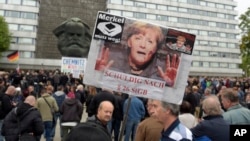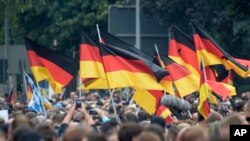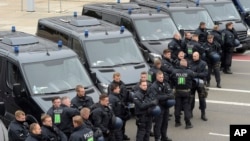No one knows what will happen in the next 48 hours in Chemnitz, the Saxon town which this week saw the worst rioting in Germany in three decades, with mobs of far-right supporters and soccer hooligans overwhelming local police and beating anyone in the streets who appeared to be a foreigner while flashing illegal Nazi salutes.
Federal authorities and neighboring German states have sent police reinforcements to Saxony to confront any repeat of the violence seen on Monday, when more than 6,000 anti-migrant protesters rallied to vent their fury at the stabbing of a 35-year-old German man, Daniel Hillig, during a brawl with a pair of asylum-seekers from Syria and Iraq.
The stabbing came at the end of a street festival celebrating the 875th anniversary of Chemnitz, a declining industrial town of drab Communist-era apartment blocks with a population of 250,000.
With four anti-migrant rallies scheduled for Saturday alone — one organized by Alternative for Germany (AfD), the far-right party that last year became the largest opposition faction in the German parliament, the Bundestag, as well as counterprotests planned by left wing groups — police are preparing for the worst.
So, too, are many store owners and the 20,000 migrants who live in Chemnitz, nestled in the foothills of the Ore Mountains, which during the Communist era was known as Karl Marx Stadt. Migrants contacted on social media say they fear for the worst.
“I won’t be going outside today [Saturday],” said Farid, a 46-year-old Moroccan who asked that his full name not be published. “And neither will my wife nor daughters,” he said.
“Will we ever be safe again?” he asked. Like many other migrants, what shocked him the most was spotting neighbors among the rioters screaming for foreigners to go home. “I wasn’t born here but my two daughters were — this is their home,” he added. He says the rioting this week, the pitched street battles between overwhelmed local police and the protesters and the hunting down of foreigners for beatings, have convinced him that a tipping point may have been reached in Chemnitz and Saxony — and “possibly in Germany as well.”
Simmering tensions
He’s not alone in harboring such a fear.
Alara, a 36-year-old Turkish woman, says she, too, has been shocked by the participation in the violent anti-migrant protests of middle-class German “neighbors and co-workers.” “I thought they were my friends,” she laments.
In the middle of the week, a shocked German Chancellor Angela Merkel expressed her fear that far right rioting, along with Hitler salutes that are banned in the country, and the confidence protesters demonstrated in flaunting their affection for a dark German past, represented a threat to the very underpinnings of the post-Second World War state.
“There is video footage of chases, rioting and hatred on the street. And that has nothing to do with our constitutional state,” she said. Tensions over migrants have roiled German politics since 2015, when Merkel announced an open-door policy for war refugees from the Middle East that saw more than 1.2 million admitted.
Merkel’s controversial immigration policy fueled the rise of the AfD. The group's electoral performance in last year’s elections, in which it seized nearly 100 seats in the Bundestag, marked a startling new phase in the party’s progress from the fringe of German politics closer to the center of power in Berlin. For far right opponents, the AfD’s election success, built on menacing social media propaganda playing on fears of Islam and Muslim criminality and on foreigners in general, represented a door opening on a German past they thought long buried.
The anti-migrant violence this week in Chemnitz — and the threat of more to come — is prompting questions about whether that door is opening even wider in Germany.
Well organized
Aside from the participation of "ordinary" locals, officials acknowledge they also were taken aback by the speed with which the anti-migrant protesters were reinforced, as well as the level of organization and coordination displayed by a variety of far right groups, including AfD, Pegida and the National Democratic Party. These groups glorify the Third Reich and have averted efforts by the government to ban it.
Saxony’s interior minister, Roland Woller, told media this week that known soccer hooligan groups with strong ties to the far right — and some with solidarity links to Russian fan-clubs and martial arts groups — helped to mobilize people from across Germany and transport them to join the street battle.
German officials blame orchestrated “fake news” peddled by far right groups on social media sites for helping to stoke the rioting that broke out Monday. “We have to acknowledge that mobilization on the internet was stronger than in the past,” said Michael Kretschmer, the state prime minister of Saxony. The trouble was fueled partially by false claims that the stabbed man had intervened to protect a woman from being raped by asylum-seekers.
The showdown in Chemnitz could continue well into next week. A concert is planned for Monday by a left-wing band. But it is the planned Saturday night marches that now have the focus. In a statement announcing its march, the AfD called Daniel Hillig “the next, avoidable victim of an irresponsible government policy that accepts the multiple deaths of natives with icy coldness.”
“The cartel media have tried to make Chemnitz, the city of the victims, into a city of the perpetrators,” the AfD statement said.
AfD senses a huge opportunity in Chemnitz, say analysts, and is determined to stoke Germany’s political divisions over migration and national identity, hoping the agitation will translate into greater electoral gains in the future.









